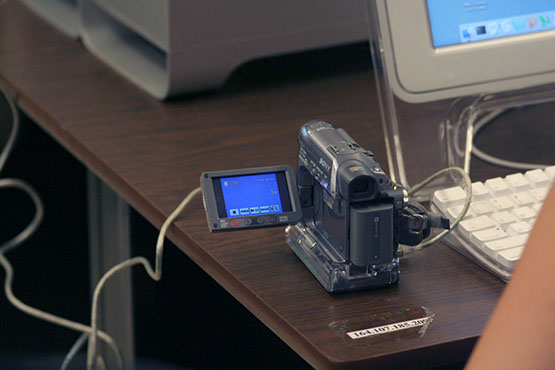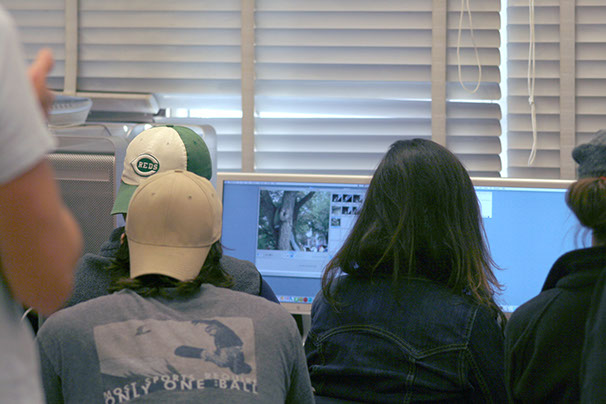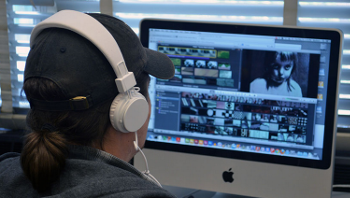Scott Lloyd DeWitt, Brian Harmon, Dundee Lackey, and Christina M. LaVecchia
Introduction | In Context | In Their Own Words | Archive | Credits
In Context (Scott Lloyd DeWitt)
In 2002, while attending the Conference on College Composition and Communication, friends persuaded me to attend the New Media segment of Computers in Writing Intensive Classes (CIWIC-NM) under the direction of Anne Frances Wysocki. The two-week workshop at Michigan Technological University in the Upper Peninsula of Michigan promised to prepare me for an upcoming professional change. I had just accepted the job as the director of the Computers in Composition and Literature on the Columbus Campus of Ohio State, and I was charged by the incoming chair with taking the program in new directions in teaching and research (as well as changing its name to reflect current practice in the field and to become more representative of the work in digital media across the department). This, without a doubt, would necessitate some training beyond my understanding of “computers and composition.”
In addition to reading and discussing scholarship in new media, the workshop was committed to new media production. Participants were taught Macromedia Director, an authoring program used for creating animated, interactive, stand-alone projects. The workshop as a whole, but mostly the production component, pushed me to think about composing in new terms and to reach beyond alphabetic print and static page layout. Composing in Director required me to compose in a timed space where I negotiated speed, duration, movement, and the relationship among objects in motion.
When I returned home to Ohio State, I quickly discovered that working with Director was going to be prohibitive because of the application’s cost, but Flash would allow me to introduce students to new media composing in similar ways, and the university had affordable licensing options I could access. Our hardware was old. Really old. I was having a difficult time convincing those holding the purse strings to invest in English studies when, in their words, “all you do is type.” I did find one sympathetic ear who was willing to listen to my vision, mostly out of curiosity because my descriptions of digital media composing were so out of the ordinary from her experience as a student who once enrolled in English classes. She asked to see some examples of that I might ask students to compose (I showed her a project I completed in CIWIC-NM along with other work I found online because I didn’t yet have student work) as well as assignment ideas. She informed me that she was in the process of upgrading a public student lab, and she offered to equip one classroom with the computers she was removing; these computers provided processor speed and memory necessary to run Flash. That next term, I asked students to create small Flash movies that combined print, images, and audio into self-portraits, documentary segments, animated quotations, and public service announcements.
Enter Video Production
After two years working with Flash and machines that were truly struggling, our programmatic efforts and the changing discipline were recognized with funding from the university to convert one computer classroom into a digital media composing studio, a space that could truly transform teaching and that would serve as a studio space for students outside of class.
promotional video for the Digital Media Project, 2005
click here to download a transcript of this video
It wasn’t long (perhaps immediately) that those of us teaching in this space realized how unprepared we were in meeting students’ enthusiasm for composing with video. This was new for all of us, and soon we faced a number of pedagogical and technical problems. Our assignment prompts, in their attempt to remain open and discover what we might learn from students, did not provide enough guidance. Students were coming to class having shot hours of raw video footage, more than they could ever work with. This was also in an era of digital video tape, which meant a 1:1 ratio of shot to upload/capture time—no drag and drop files. Students wanted to create feature-length documentaries. Very few of them owned computers capable of working with video, so they were restricted to working in our studio. And finally, we had not provided proper file storage for students. The computer hard drives were locked down by our IT providers, no one possessed external hard drives, and DVD burning was simply not practical.
Concept in 60: Take 1
 the Digital Media Project’s first generation digital video camera, 2006
the Digital Media Project’s first generation digital video camera, 2006In 2006, in response to our initial venture into video composing, I drafted the initial version of the prompt that would later become widely known as “Concept in 60.” Its purpose was to place a few constraints on students to teach the power of editing, to introduce them to short-form content (and, related, to shooting less footage than they were inclined to do), and to prepare them for a slightly larger project at the end of the term. It was framed as a low-stakes exercise, and students were asked to complete it in a relatively short amount of time (approximately a week). In this first iteration, students were allowed to compose video, audio, or Flash projects (they had previously received instruction in audio and Flash, and I used the Concept in 60 assignment to teach them basic video production, but the choice was ultimately theirs).
click here to download this prompt
 large-capacity external hard drives became a necessity
large-capacity external hard drives became a necessity
when students began to manage large video files, 2006
An overwhelming number of students opted to compose video projects. We purchased a number of large, desktop external hard drives for students to use in the classroom, and we convinced our IT department to partition the computer hard drives, creating a segment that would not be wiped every twenty-four hours, so that students could back up work to a second location.
Unfortunately, I do not have permission to use that student work for this publication (it was eight years ago, and those students have long since left the university). I do still possess the student work, as well as the written assessment of that work, and it’s clear how that first experience altered future iterations of the assignment:
- Students appreciated the focus in subject matter the assignment required, but felt limited in the focus itself. They revealed that the campus had become commonplace to them, and they did not know much about the city of Columbus. Additionally, the short time they had to produce the work conflicted with them finding an interesting topic within the assignment’s constraints.
- Assessment often revealed that students struggled with the outcome, “Your project must take a critical approach to its subject matter.” Projects were often simply about a location and lacked a “take” on that place.
- The length of the project, even at two minutes, was still too long. Students did not fully utilize what Scott McCloud would call “the gutters.” Without an even stricter restriction in duration, students did not feel the need to approach their subject matter conceptually.
- The single most prevalent example of the duration problem was the talking head. When subjects were interviewed, we saw them speaking, often in very uninteresting settings and with unflattering framing, with very little attention to editing (matters which quickly became features of video production instruction).
Concept in 60: Take 2
 Ohio State students working collaboratively on video projects, 2006
Ohio State students working collaboratively on video projects, 2006The next version of the assignment addressed these issue (as well as some minor matters) and has, to date, remained relatively unchanged.
The assignment’s next three-year history might be best explained as “proliferation.” Faculty and graduate students at Ohio State who were assigned to teach classes in our digital media studio/classroom used the assignment as a means of providing structure and support to their initial experiences teaching video production. Graduate students who finished their degrees and took jobs at other universities began to teach the assignment to their new students and to assist their new colleagues with their initial experiences teaching video production. Instructors often slightly altered the topic for the videos, aligning it more with course content, but the objective remained, for the most part, unchanged.
Concept in 60: Take 3
 DMAC participants working on video production
DMAC participants working on video productionIn 2009, we introduced “Concept in 60” into the curriculum of The Digital Media and Composition Institute. Often referred to as “DMAC in 60” or “Multimodality in 60,” the assignment remained nearly identical to the assignments we taught to our students on campus except we asked participants to “create a 60-second video text that illustrates the concept of multimodality.” At the time, Ohio State was on a ten-week quarter system. DMAC included ten days of instruction. Whereas universities often think of “contact” hours as breaking down into one day equaling one week, this did not translate into time outside of class. Participants were given about three days to work on the project, including instruction in video shooting and editing, less than what Ohio State students were typically given. Because of the material DMAC staff members felt they needed to cover in the DMAC curriculum, we weren’t able to dedicate more time to the assignment. Although we recognized that composing with video was still very new to DMAC participants, we also reminded ourselves that DMAC participants are made up of teachers, writers, and advanced graduate students, so we hoped that areas like invention and topic development might come to them easier and faster than it might to an undergraduate student.
The challenge presented by the assignment itself and the pace of the institute was considerable, but the opportunities for participants to reflect on what it means to learn and to teach were equally significant. The examples and stories you are going to see in this webtext respond to that prompt, all of which were composed for DMAC 2013.
Author
 Scott Lloyd DeWitt is an Associate Professor and Vice Chair of Rhetoric, Composition, and Literacy in the Department of English at The Ohio State University. His book Writing Inventions: Identites, Technologies, Pedagogies (SUNY 2002) won the 2003 Computers and Composition Distinguished Book Award, and he is currently examining a corpus of 5000+ pieces of student writing for a book called The Optimistic Turn: Authentic Contexts for Peer Review in Composition Instruction. With Cynthia Selfe he serves as Director of DMAC.
Scott Lloyd DeWitt is an Associate Professor and Vice Chair of Rhetoric, Composition, and Literacy in the Department of English at The Ohio State University. His book Writing Inventions: Identites, Technologies, Pedagogies (SUNY 2002) won the 2003 Computers and Composition Distinguished Book Award, and he is currently examining a corpus of 5000+ pieces of student writing for a book called The Optimistic Turn: Authentic Contexts for Peer Review in Composition Instruction. With Cynthia Selfe he serves as Director of DMAC.
